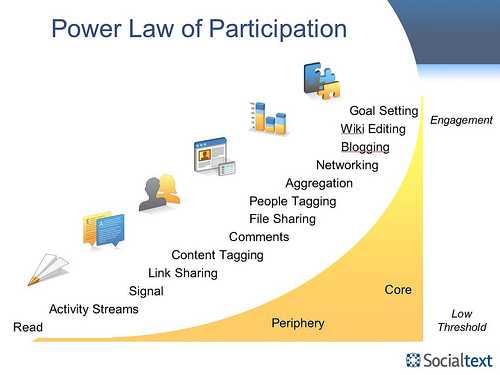Three adoption patterns for educational social software
Posted November 18, 2009
I’ve been reading and thinking a lot lately about how to drive more adoption of the social learning platform I’m building here at BYU, https://island.byu.edu, and wanted to summarize some of the highlights of what I’ve learned. All of the patterns come directly from Ross Mayfield and Michael Idinopulos’s writings so a big shout out to the great work they’re doing at Socialtext.
Pattern 1: Launch Broad then Deep
I wrote extensively about this pattern about a month ago in my post Deploying Social Software in Universities: Go Broad then Deep. The crux of the argument is that when deploying social software, you should first aim to get wide adoption, sign up as many people as possible, before trying to facilitate deeper, more complex engagement between your users. Social software without people is useless or as Michael Idinopulos puts it, “Scale is the oxygen that feeds collaboration.” In the competitive web2.0 world, the simplest tool almost always will win.
Once you’ve achieved broad adoption, the next step is to go deep. To quote Michael again, “[after achieving scale] deliver deep value by following up with local champions [deans, teachers, students] who want to invest time and effort in more robust, group-specific forms of collaboration.”
So launch simply and broadly. Let students and teachers adjust to having a web-enabled learning environment. Then go deep by building into the social learning platform higher-value tools such as blogs, wikis, and other collaborative learning tools and workflows.
Pattern 2: Help Learners Climb the Participation Curve
Ross Mayfield came up with a beautiful concept a number of years ago called the ”Power Law of Participation”
Reproduced image:
The essence of the model is that in any community, the vast majority of the members will not have a very high level of engagement with the community. For example, in most classes there will be a few students who actively participate while the rest play solitaire. When you first deploy social learning software, most learners will only participate by reading. While they do get value from reading and lurking in communities, learners will benefit even more if they move up the participation curve and engage more deeply in some of the communities they participate in.
Software adoption can be thought of in two dimensions, broad and deep. If your learners are successfully engaging in higher value / engagement tasks on your site, this deep adoption is occurring.
Pattern 3: Focus on Creating Value
It’s far to easy to focus on the tools we use rather than the value we’re trying to create (See Jon Mott’s blog, ”The End in Mind” for an extended discussion on this subject). Adoption will increase if we focus on more creating value (making our users awesome) and less on the specific tools we are building/using.
A social learning platform can add value to educational institutions in four contexts (See Michael’s post The Social Software Value Matrix for more):
- Within the classroom
- Within departments
- Within the institution
- Across multiple institutions
Socialtext recently released a white paper on the 6 Ways to Get Business Value from Social Software. They discuss there how social software can greatly improve the formal and informal processes in each of the contexts that social software operates in.
Formal processes they define as “those things your organization does on a repeated basis.”
In an educational environment those would be things such as lectures, quizzes, studying, group projects, writing essays, exams, and so forth.
Informal processes they define as “all the many interactions that take place outside of this [formal] structure. They are not predictable and repeated, and therefore cannot be codified and defined… Informal processes make up the bulk of [learners] interactions.”
In an educational environment informal processes would include such activities as informal study groups, conversations in hallways, individuals or small groups meeting with professors or TAs, forums, clubs, and so forth.
Within an educational institutions there are many formal and informal learning processes that can be improved. As we focus on identifying poor processes and creating learning tools that clearly improve them, adoption of our social learning software will increase.
Subscribe to get updated on new posts!
Kyle Mathews lives and works in Seattle building useful things. You should follow him on Twitter. Currently exploring what's next and open to consulting.
